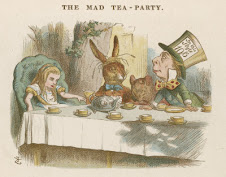On New York's general election ballot, 2010, there are at least four candidates in all of the races for statewide offices (excluding elections for the judiciary). However, in the 241 races for US House, State Senate and State Assembly, there are only 39 contests in which there are more than two candidates on the ballot; and there are 37 in which there is only one! These are just some of the findings from a Poli-Tea study and analysis of New York's general election ballot.
(To check out NY's certified general election ballot for yourself, visit the web page of the New York Board of Elections and follow the appropriate links. For links to all the ballot-qualified candidates for state-wide and congressional races in NY, see the New York State page at Politics1.)
Introduction
New York is well known for its electoral fusion voting system. Under this arrangement, a candidate for public office can obtain the endorsements of more than one political party. On the ballot, the candidate's name is listed under the ballot lines of each of the parties by which he or she has been endorsed, allowing voters to cast their vote for that candidate under the party banner of their choice. For instance, in the state's gubernatorial race, Democrat Andrew Cuomo has been endorsed by the Democratic Party, the Independence Party, and the Working Families Party, while Republican Carl Paladino will appear under the ballot lines of the Republican Party, the Conservative Party and the Tax Payers' Party.
This system is widely seen as empowering minor parties, since major party candidates seek to obtain their endorsements, which can prove decisive in a given contest. In 2009, when Michael Bloomberg was elected mayor of New York City, it was the votes he received on the Independence Party's ballot line that provided him with his margin of victory over Democrat Bill Thompson. However, if New York's minor parties simply endorse major party candidates in the majority of races, it becomes clear that they are not an independent force in the state's politics, but rather a rubber stamp in favor of the political status quo embodied by the Democratic-Republican party establishment.
Findings
What does the New York State ballot look like in the 2010 elections? Excluding judicial contests, this year, at the top of the ballot there are:
• 7 candidates for Governor on 11 ballot lines
• 6 candidates for Lieutenant Governor on 10 ballot lines
• 4 candidates for Comptroller on 7 ballot lines,
• 4 candidates for Attorney General on 7 ballot lines
• 7 candidates for US Senator (Clinton vacancy seat) on 11 ballot lines
• 4 candidates for US Senate on 8 ballot lines
• There are 29 seats in New York's delegation to the House of Representatives. There are at least two candidates in all of these races. There are more than 2 candidates in 9 of these 29 races (31%). In 7 of these contests, there are 3 candidates; in the remaining 2 races there are 4 candidates.
• New York's State Senate has 62 members. In 8 of these races, or 13%, there are more than two candidates on the ballot. There are 7 races with three candidates and one with 4 candidates. In five of these races, or 8%, there is only one candidate on the ballot.
• There are 150 seats in New York's State Assembly. There are more than two candidates in 22 of these races, which is just under 15%. In 20 of the latter races there are three candidates, and there are four candidates in the remaining 2 contests. However, in 32 of the races for NY State Assembly, just over 21%, there is only one candidate on the ballot.
• The great majority of races feature only Democratic and Republican party candidates, often with the cross-endorsements of one or more minor parties. The Working Families Party tends to endorse Democrats. The Conservative Party tends to endorse Republicans. The Independence Party can be found endorsing Democrats or Republicans.
• In races for US House, State Senate and State Assembly, the Conservative Party is running more independent candidates than any other minor party, with 4 candidates for US House, 4 for State Senate and 11 for State Assembly. They are followed by the Working Families Party, which has endorsed 2 independent candidates for State Senate and 6 independent candidates for State Assembly. (By 'independent candidate,' here, I mean an individual who has not been endorsed by the Democratic or Republican parties.)
• In the same set of races, i.e. US House, State Senate and State Assembly, the Green Party is running 6 candidates and the Libertarian Party only 1. If the Green and Libertarian candidates for governor receive more than 50,000 votes in this election, their parties will be assured a ballot line for the next four years, thus potentially facilitating the growth of the Green-Libertarian opposition to the Democratic-Republican two-party state in New York.
• Question: what do you make of the disparity between the multiplicity of candidates for all the statewide offices, versus the relative paucity of choice in district-based races?
• Question: what does the breakdown look like in your state?
Unfortunately, over the weekend, I did not have time to cross-reference this year's ballot with that of any previous election, and so cannot draw any conclusions on whether there are more or fewer independent, third party candidates on the New York ballot in 2010. However, if you are in possession of such information, please relay the info or a link by email or in the comments.
If you'd like more detailed info on any of the above races, or categories of races, or about a specific party, feel free to ask in the comments. I gathered a bit more info from the ballot than is relayed above.
Subscribe to:
Post Comments (Atom)







No comments:
Post a Comment